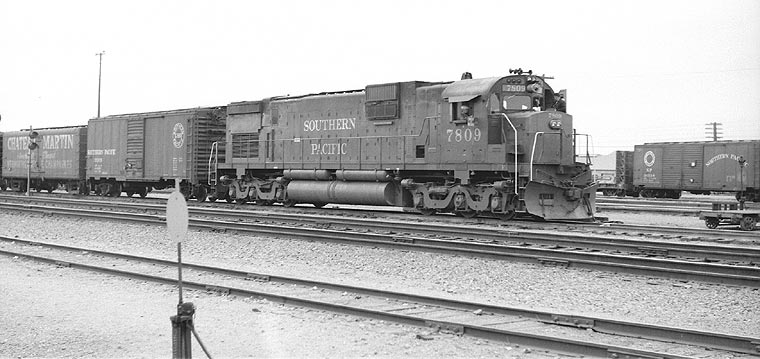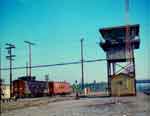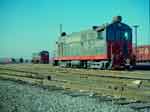
San Jose / Santa Clara
last addition 3-2-25
SP San Jose
Elsewhere, you'll find a 1947 Newhall Yard Track Capacities map.
We are looking at the same, but different photos; musings about working for SPMW on Newhall Yard track #1 (now Main Track #1 in 1983 - including a gorgeous David Rector photo of a Caltrain plug.
Newhall Yard, the same day, looking timetable west (today's timetable north). FMH12-44 2357 (with 'ashcan" headlights.and old (built 1944) Alco S-2 1718 share the duties. The tower is behind the photographer. In the background is old (1944) Alco S-2 #1718, one of whose ranks would be severely depleted by the coming of SW-1500's in the next couple of years. Fairbanks-Morse H12-44's like the 1953-built, ashcan headlight-equipped #2357 would hang around for another ten years, or so. The FM's had touchy governors, and often when under heavy load they would put out cyclical high-to-low revs, sounding like runaway vacuum cleaners. One smart engineer figured out that if he stuck a penny(s) into the governor somewhere, the problem would cease.

Here we see the eastbound 7809's engineer patiently reading (company material, I'm sure!) while the car department finishes making and testing the air at the bottom (east) end of Newhall Yard. After completing the air test, the carmen will remove the blue flag underneath the hoghead's elbow. The train is sitting on yard track #1, which is now Main Track 1. For those with DSL, or patience, I've included a monster (280k) version of the photo.
Notice the Chateau Martin reefer , an ex milk car, which probably will be set out at the winery in San Martin.
The 'signal' next to the reefer is actually a Train Indicator for westbound trains approaching Santa Clara platform. If the bottom light displayed the word "clear", no eastbound train was at, or approaching Santa Clara, and it was probably safe for a westbound to stop at, or pass through Santa Clara platform. If the top "train" light was lit, the westbound train would, by rule, hold-out of the station until the eastbound had left. It and many at other locations lost their train indicators during the 1990's, much too the chagrin of us commute engineers, who heavily relied upon them.
Also, notice the hayburner on top of the switchstand in front of the NP boxcar. Within a year or two, the kerosene switch lanterns would be replaced with diamond-shaped Scotchlite-painted targets. The old round targets (foreground) were not Scotchlited. Incidentally, electrified hayburners survived on some flip-flop switches under the charge of Roseville's 245 herder (top end of yard) until at least 1986. They were securely attached to the stand.
new 3-2-25: The end is near for San Jose's Newhall Yard: Although SP had ripped out half of its tracks more than a decade prior, the other half (+yard office, -tower) still remained in December 2004, as above. Back then Altamont Express stored its cars during midday layover on the Santa Clara Drill & Siding across the main tracks from the yard, and UP used the former caboose track to park locos in between jobs. The relatively new remote control alert was only a sign of the times for the short while before UP bullzozed the rest of the yard, save one track. The tower once stood just outside photo left.


